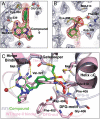Chemical genetic strategy for targeting protein kinases based on covalent complementarity
- PMID: 21852571
- PMCID: PMC3174669
- DOI: 10.1073/pnas.1111239108
Chemical genetic strategy for targeting protein kinases based on covalent complementarity
Abstract
The conserved nature of the ATP-binding site of the > 500 human kinases renders the development of specific inhibitors a challenging task. A widely used chemical genetic strategy to overcome the specificity challenge exploits a large-to-small mutation of the gatekeeper residue (a conserved hydrophobic amino acid) and the use of a bulky inhibitor to achieve specificity via shape complementarity. However, in a number of cases, introduction of a glycine or alanine gatekeeper results in diminished kinase activity and ATP affinity. A new chemical genetic approach based on covalent complementarity between an engineered gatekeeper cysteine and an electrophilic inhibitor was developed to address these challenges. This strategy was evaluated with Src, a proto-oncogenic tyrosine kinase known to lose some enzymatic activity using the shape complementarity chemical genetic strategy. We found that Src with a cysteine gatekeeper recapitulates wild type activity and can be irreversibly inhibited both in vitro and in cells. A cocrystal structure of T338C c-Src with a vinylsulfonamide-derivatized pyrazolopyrimidine inhibitor was solved to elucidate the inhibitor binding mode. A panel of electrophilic inhibitors was analyzed against 307 kinases and MOK (MAPK/MAK/MRK overlapping kinase), one of only two human kinases known to have an endogenous cysteine gatekeeper. This analysis revealed remarkably few off-targets, making these compounds the most selective chemical genetic inhibitors reported to date. Protein engineering studies demonstrated that it is possible to increase inhibitor potency through secondary-site mutations. These results suggest that chemical genetic strategies based on covalent complementarity should be widely applicable to the study of protein kinases.
Conflict of interest statement
The authors declare no conflict of interest.
Figures




References
-
- Zhang J, Yang PL, Gray NS. Targeting cancer with small molecule kinase inhibitors. Nat Rev Cancer. 2009;9:28–39. - PubMed
-
- Fedorov O, Muller S, Knapp S. The (un)targeted cancer kinome. Nat Chem Biol. 2010;6:166–169. - PubMed
-
- Iyer R, Fetterly G, Lugade A, Thanavala Y. Sorafenib: a clinical and pharmacologic review. Expert Opin Pharmaco. 2010;11:1943–1955. - PubMed
Publication types
MeSH terms
Substances
Associated data
- Actions
Grants and funding
LinkOut - more resources
Full Text Sources
Other Literature Sources
Miscellaneous

